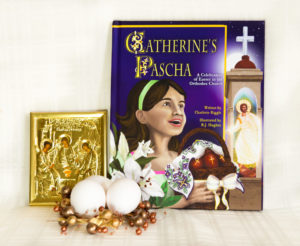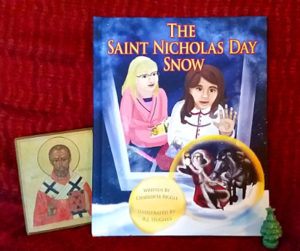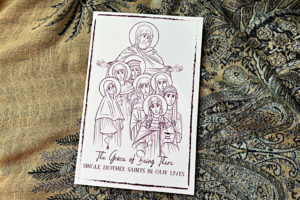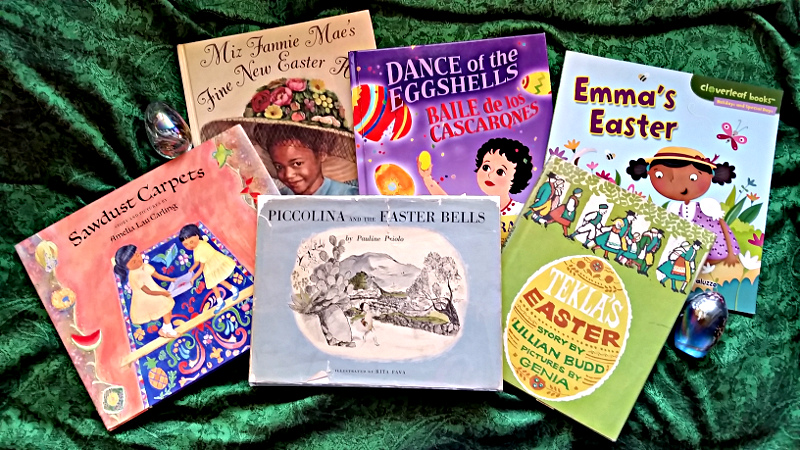For over two thousand years now, people have celebrated Easter with great joy and a dazzling variety of traditions. And it seems natural that the joy and the traditions would find their way into picture books.
It would be natural, but it’s not common. When I created this book list back in 2017, I had managed to track down sixteen multicultural Easter picture books published since 1950. I’ve found two more since then. To be included on my list, the book has to be about people celebrating Easter as a religious holiday. Bunnies and baskets and eggs aren’t enough. If you know of an Easter picture book that belongs on the list, let me know!
The best multicultural Easter picture book
I would like to say that my own book, Catherine’s Pascha, is the best Easter picture book ever published. But that wouldn’t be true.
If I could have just one multicultural Easter picture book, it would be Chicken Sunday by Patricia Polacco.
The book is a masterpiece. The main characters are a Ukrainian-American girl and her two best friends, who are African American boys. The boys’ grandmother and a Jewish hatmaker are also important to the story.
The children want to buy the boys’ grandmother a new Easter hat. The hatmaker thinks they’re the children who have been throwing eggs at his store. It’s not fair. But the grandmother tells the children they need to earn his trust. Which they do, using pysanky eggs.
Tiny details in the illustrations reveal a lot about the characters. The girl says she and the boys aren’t the same religion; they’re Baptist. She doesn’t say what her faith is, but in her home you can see icons and a lampada; she’s Eastern Orthodox. The hatmaker has a number tattooed on his arm. He is a Holocaust survivor.
Details like that enrich the story for older readers without making it too complex for little ones.
Picture books about Orthodox Easter
For Orthodox Christians, Pascha is the Feast of Feasts. It’s like New Year’s and Christmas and Thanksgiving and the fourth of July all rolled into one amazing celebration. And there are three different picture books that give you a hint of what it’s like to be there.
I wrote Catherine’s Pascha for my own children, when I couldn’t find the Easter picture books I wanted for them. It’s about a little girl celebrating Easter according to the Orthodox Christian tradition. Catherine and her family go to church in the middle of the night. There are candles and processions, incense and icons, and shouts of “Christ is risen!” in many languages. And after the service, there’s a party that lasts until sunrise. The pages are framed by illustrations of Orthodox churches from all over the world. Read the reviews.
The Lucky Egg by Anna Prokos tells the story of another young child celebrating Pascha. Billy also attends church with his family in the middle of the night. After the service, they go home to share a special Pascha meal.
When I first read Mother Melania’s Pascha at the Duckpond, I wasn’t sure if it belonged on my list. The main characters in the book are animals, and most of the action story takes place during Lent. But at the end of the story, the animals join the people at the monastery for the celebration of Pascha. That’s enough.
Other multicultural Easter books
There are a handful of other books that provide a rich multicultural story.
Perhaps the most unusual of these books is Sawdust Carpets by Amelia Lau Carling. The book is about a Chinese family who has immigrated to Guatemala. The mother doesn’t read Spanish very well; the children can’t read Chinese. Their relatives in Antigua have both the Virgin of Guadalupe and the Chinese goddess Kuan Yin in their prayer corner. And the children help create the beautiful, ephemeral sawdust carpets for the Good Friday processions through the streets of the city.
The Dance of the Eggshells/Baile de los Cascarones by Carla Aragón is a brightly colored bilingual book set in Santa Fe, New Mexico. Libby and her brother, J.D. join their grandparents for the celebrations that follow Easter day. There are eggs filled with confetti, traditional costumes, and traditional dances, shared with a dash of history and a pinch of sibling conflict. Although the writing isn’t as polished as Chicken Sunday or Sawdust Carpets, it’s a delightful book.
Miz Fannie Mae’s Fine New Easter Hat, by Melissa Milich, is a warm and gentle story set in a rural African American community in the time that horse-drawn wagons shared the roads with cars, and people got their milk delivered to their door every morning. The story is narrated by Tandy, Miz Fannie Mae’s daughter, who speaks in a rural African American vernacular. The church service on Easter Sunday features fine new hats for all the women, enthusiastic preaching, a starling, and a miracle.
Tekla’s Easter by Lillian Budd was published in 1962. It’s the story of a little girl celebrating Easter in Sweden. There are bonfires and witches, traditional costumes, and a boat ride to the mainland for church on Easter morning. After church, the family’s Easter dinner includes storytelling and lots of eggs.
Piccolina and the Easter Bells by Pauline Priolo was also published in 1962. It’s set in Sicily, at a time when people traveled by horse and carriage rather than by car, and chickens and pigs roam the streets of the village. Piccolina is a tiny girl who wants to be tall. And there was a custom in Sicily that children who were lifted high in the air when the Easter bells rang on Holy Saturday would grow tall in the coming year. A Traveller boy is part of the story; Priolo refers to him as a gypsy boy. Many people consider the word offensive, although it’s unlikely that the author meant any offense. Nevertheless, it’s important to mention when you read the story with children.
Emma’s Easter by Lisa Bullard is geared toward younger readers than the other books. It’s a simpler and more familiar story. The family colors Easter eggs on Saturday. On Sunday is church, an Easter egg hunt, and dinner with the extended family. The story is remarkable only because Emma is a biracial child; her father is Black, and her mother is Russian. Emma’s Russian grandmother brings kulich, a traditional Russian Easter bread, to Easter dinner. Sadly, the book doesn’t mention that the Russian grandmother was probably up all night at Easter services before coming to dinner with Emma’s family.
The oldest multicultural Easter picture book
The oldest multicultural Easter picture book I have found is The Egg Tree, by Katherine Milhous.
The book, which shows a Pennsylvania Dutch Easter, is the only Easter book ever to have received a Caldecott Medal. On that basis alone, it belongs in every collection of Easter books. But I’ll have to admit I’m not crazy about it; the story seems fragmented, and the illustrations are uninspiring.
Russian Easter stories
The next three multicultural picture books are modern fairy tales set in Russia during the Easter season.
Marushka’s Egg, by Elsa Okon Real, isn’t really an Easter story. It’s a Baba Yaga story, complete with the hut on chicken legs. But it begins on Easter morning, with Marushka going to the market to buy an egg for her mother’s Easter bread.
The Magic Babushka, by Phyllis Limbacher Tildes, also features a Russian witch. But this is a good witch, the shape shifter Baba Babochka. (As far as I know, Baba Babochka is Tildes’s creation. But she certainly has the feel of a folk character.) The story is filled with pysanky eggs, the tsarina’s court, and magic. Oh, and love
In Rechenka’s Eggs, by Patricia Polacco, an old woman, Babushka, lives alone in a cozy house full of warm rugs and warm quilts. She has icons on the wall and tea in her cup. She keeps herself busy in the long winter nights by making pysanky eggs. When a goose is injured by hunters, Babushka takes her in and names her Rechenka. Babushka cares for Rechenka until it’s time for the Easter festival, and time for Rechenka to fly away. But there are miracles to see before Rechenka leaves.
Diverse Easter books for the youngest readers
To include board books in my list, I had to take a rather expansive view of what it means to celebrate Easter. All four of these multicultural Easter books for toddlers feature simple rhyming text and standard Easter conventions.
Bunny Day is a sturdy board book with photos of happy babies with flowery hats, jelly beans, Easter eggs, and bunnies. Most of the little ones in the book are White, but it does include Black children, and one Asian child on the cover. The photographer is Michael Scott; the writer is Pascale Lapin (but you have to read the copyright notice on the back of the book to find the writer’s name!)
Easter Sparkling Surprise is a board book by Elizabeth Spurr. The story follows a Black girl and a red-headed boy on an Easter egg hunt. As the title suggests, it has lots of sparkle on the illustrations. An almost painful amount of sparkle, in fact. The girl wears pink and purple; the boy wears green and beige. I imagine this book would delight most three-year-olds.
Painted Eggs and Chocolate Bunnies (with text by Toni Trent Parker and photographs by Earl Anderson) is printed on card stock, and has a padded cover. It’s not quite a board book, but sturdier than a regular book. Like Bunny Day, it features photos of happy little ones. But the children in Painted Eggs and Chocolate Bunnies are preschoolers, not babies. And every single one of them is Black.
Easter by Mirian Nerlove shows a Black family celebrating Easter with an Easter egg hunt, church, and Easter dinner with the extended family. When the family goes to church, there’s a four-page digression that tells of Jesus’s death and resurrection.
Other Easter Picture Books
Even if you want to focus on multicultural Easter picture books, you might want to round out your collection with a book that focuses on bunnies and baskets and eggs.
You won’t go wrong with The Easter Egg by Jan Brett and The Country Bunny and the Little Gold Shoes by DuBose Heyward. While the characters in both books are bunnies, they both have multicultural themes. And they’re both simply fabulous books.
If you are looking for a picture book that tells the Gospel story of Easter, there’s only one that you need: The Easter Story by Brian Wildsmith. The illustrations are luminous, and Wildsmith manages to tell the story (which is really quite brutal) in a way that is both honest and appropriate for children.
Read More
17 ways to use Catherine’s Pascha: From crafts to culinary arts to literary criticism, you’ll find activities to engage all your children with Pascha.
Easter picture books keep Pascha present: Keep reading Easter picture books with your little ones, from Pascha all the way to Pentecost — or at least until Ascension. The books will help build their love for Easter.
Pascha for families with disabilities: If you have children with disabilities (or if you have a disability yourself), your celebration of Pascha might need to be adjusted a bit, so that you can celebrate in peace and in joy.
Books by Charlotte Riggle

This holiday classic shares the joy of Pascha through the eyes of a child. Find it on Amazon or Bookshop.org.
![]()

This delightful story is filled with friendship, prayer, sibling squabbles, a godparent’s story of St. Nicholas, and snow. Lots and lots of snow. Find it on Amazon or Bookshop.org.
![]()

In this collection of essays, women who are, or have been, single mothers share stories of their relationships with saints who were also single mothers. Charlotte’s story of the widow of Zarephath highlights the virtue of philoxenia. Find it on Amazon or Park End Books.











How lovely to find this list. It’s a great Lenten opener, in and of itself, and makes me wish there were children around to share these books with. Maybe another season… I also had to smile at the name of the author for Bunny Day – Pascale Lapin: Pascha Rabbit 🙂